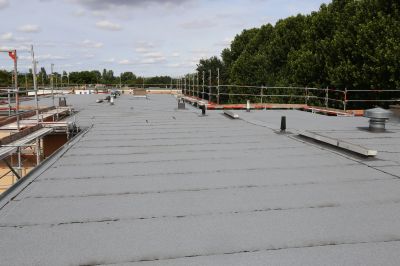Expert Picks For Flat Roofing Service Supplies and Tools
Find out which products industry experts recommend for achieving superior flat roofing service outcomes.
 Flat roofing services require a diverse range of products to ensure proper installation, maintenance, and repair. From protective coatings to specialized sealants, each component plays a vital role in maintaining the integrity and longevity of flat roofs. Selecting the right products depends on factors such as roof material, climate conditions, and specific project requirements. Professionals often rely on a combination of durable materials and innovative solutions to address common issues like leaks, ponding water, and surface wear.
Flat roofing services require a diverse range of products to ensure proper installation, maintenance, and repair. From protective coatings to specialized sealants, each component plays a vital role in maintaining the integrity and longevity of flat roofs. Selecting the right products depends on factors such as roof material, climate conditions, and specific project requirements. Professionals often rely on a combination of durable materials and innovative solutions to address common issues like leaks, ponding water, and surface wear.
Top Overall Option
Multi-Functional Flat Roofing System
A versatile flat roofing system that combines waterproof membranes, reflective coatings, and sealing components to provide comprehensive protection. Designed for ease of installation and durability, this system is suitable for various flat roof types and conditions. Its layered approach helps resist water infiltration, UV damage, and surface wear, making it a reliable choice for ongoing maintenance and repairs.
Types of Products For Flat Roofing Service
Waterproof Membranes
Essential for creating a water-resistant barrier on flat roofs, available in various materials such as EPDM, TPO, and PVC.
Roof Coatings
Reflective and protective coatings that extend roof lifespan and improve energy efficiency.
Sealants and Adhesives
Used to seal joints, seams, and penetrations to prevent leaks and ensure secure attachment of roofing components.
Insulation Boards
Insulation materials that help regulate temperature and prevent thermal bridging on flat roofs.
Drainage Products
Components like roof drains and scuppers that facilitate water runoff and prevent ponding.
Patching and Repair Kits
Quick-fix solutions for minor damages, including patches, tapes, and repair compounds.
Flashing Materials
Metal or flexible flashing used to seal around roof edges, vents, and other penetrations.
Vapor Barriers
Materials designed to prevent moisture buildup within roofing assemblies.
Ballast and Surfacing
Protective surfacing options like gravel or pavers that add weight and protection to roofing systems.
Roof Edge Systems
Edge detailing components that secure roofing membranes and provide wind uplift resistance.
Fasteners and Anchors
Secure attachments for membranes, insulation, and other roofing components.
Drain Covers and Strainers
Protect drainage outlets from debris and clogging, ensuring proper water flow.
Roof Ventilation Products
Ventilation solutions to prevent moisture buildup and promote airflow.
Roof Edge Drip Edges
Metal or rubber components that direct water away from roof edges and prevent damage.
Surface Primers
Preparation products that improve adhesion of coatings and sealants.
Popular Choices
Flexible and durable membranes commonly used for flat roof waterproofing.
Thermoplastic polyolefin sheets known for their reflective properties and ease of installation.
Polyvinyl chloride membranes valued for chemical resistance and longevity.
High-sheen coatings that reflect sunlight to reduce heat absorption.
Versatile sealants used for sealing joints and small penetrations.
Ease of application makes these membranes popular for quick repairs and overlays.
Drainage mats help facilitate water runoff and prevent ponding issues.
Flexible tapes designed for quick patching of minor roof damages.
Commonly used for sealing around roof penetrations and edges.
Heavy stones used to hold down membrane systems and provide surface protection.
Vents designed to promote airflow and reduce moisture accumulation.
Components that secure roofing membranes at the edges and provide wind uplift resistance.
Preparation products that enhance adhesion of surface coatings.
A comprehensive flat roofing system typically involves multiple layers and components. Waterproof membranes serve as the foundational barrier against water intrusion, while adhesives and sealants ensure a secure attachment and seal around edges and penetrations. Protective coatings can extend the lifespan of the roof by providing resistance to UV rays and physical damage. Maintenance products, such as cleaning solutions and patching compounds, help preserve the roof's condition over time.
Understanding the variety of available products allows contractors and property owners to make informed decisions tailored to their specific needs. Proper application and compatibility are crucial to achieving optimal results. Therefore, selecting high-quality, reliable products from reputable sources can significantly impact the durability and performance of a flat roofing system. Regular inspections combined with the right products can prevent costly repairs and prolong the roof's service life.
Key Buying Considerations
- Compatibility with existing roofing materials to ensure proper adhesion and performance.
- Weather resistance properties suitable for your climate conditions.
- Ease of installation, especially for DIY projects or quick repairs.
- Durability and lifespan of the product in terms of UV exposure and physical wear.
- Flexibility to accommodate roof movements and temperature fluctuations.
- Waterproofing capabilities to prevent leaks and water intrusion.
- Compatibility with other roofing components such as flashing and insulation.
- Ease of maintenance and availability of repair products.
- Safety features, including non-slip surfaces or fire resistance where applicable.
- Cost-effectiveness considering the product's longevity and performance.
- Manufacturer reputation and reviews to gauge reliability.
- Environmental conditions like ponding water or debris accumulation that may affect product choice.
- Warranty options and support from suppliers.
- Application methods and whether specialized tools or skills are required.
- Regulatory compliance and adherence to local building codes.
This page contains affiliate links. We may earn a commission if you make a purchase through these links, at no additional cost to you.
